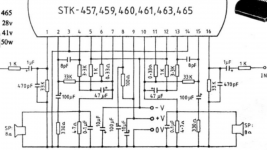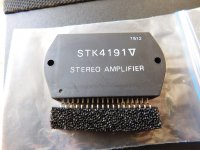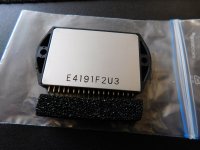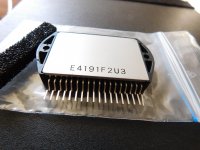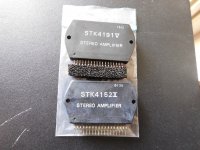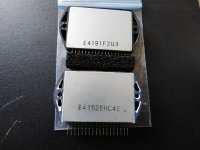When you see the rectangular chip with the orbit logo and 9 dots inside, that STK is for mass market black box audio. It is probably special order for that task. The datasheet = service manual from whatever mass market amp it was special ordered for. Those STK chips are not the charming classics we seek. Headline figure involving 1%THD is a clue.
stk463
Can anyonehelp me out with a picture of the veroboard circuit for the amp using the 463. I have a picture of the circuit but having a hard time with getting itbon veroboard. Im not the greasted with computers.
Can anyonehelp me out with a picture of the veroboard circuit for the amp using the 463. I have a picture of the circuit but having a hard time with getting itbon veroboard. Im not the greasted with computers.
Attachments
Hi!
I just bought some STK4191V chip amps from an Ebay shop in Europe.
The shop promised these were genuine Sanyo chips but as many fakes are in circulation I want a second and third opinion...
If these are not Sanyo I would like to know if anyone has experience with using chips from the maker of these chips and who the maker might be.
The chips do look very well made, the only thing I can spot looking a bit off is that the surface of the package is a bit too smooth and uniform compared to the known to be real Sanyos I have access to.
I just bought some STK4191V chip amps from an Ebay shop in Europe.
The shop promised these were genuine Sanyo chips but as many fakes are in circulation I want a second and third opinion...
If these are not Sanyo I would like to know if anyone has experience with using chips from the maker of these chips and who the maker might be.
The chips do look very well made, the only thing I can spot looking a bit off is that the surface of the package is a bit too smooth and uniform compared to the known to be real Sanyos I have access to.
Attachments
Last edited:
I desoldered a genuine Sanyo STK module, it's not the exact same model but it's a compatible one using the same package.
When you have them side by side it's easy to see they are not at all the same.
Either Sanyo did some retooling as the edges are different and and also changed the resin for the package as it also is different or the ones I got are fake.
On the backside we find that Sanyos engraving isn't deep at all while the the new module has a much deeper and clearer engraving.
What do you think, is this evidence good enough for Ebay?
I'm thinking that I might need to test one module and if it shorts out smash it apart to get conclusive evidence.
When you have them side by side it's easy to see they are not at all the same.
Either Sanyo did some retooling as the edges are different and and also changed the resin for the package as it also is different or the ones I got are fake.
On the backside we find that Sanyos engraving isn't deep at all while the the new module has a much deeper and clearer engraving.
What do you think, is this evidence good enough for Ebay?
I'm thinking that I might need to test one module and if it shorts out smash it apart to get conclusive evidence.
Attachments
hi, do you think that stk41xx or stk42xx amps need preamp?
Need of a preamp is unlikely but could happen if the source is so weak that the source output prevents playing loud enough. Need of a preamp can also happen if playing loud enough strains the source unacceptably so that its condition, while doing so, is not suitable to amplify. The most modern sources are a bit weak.
Need of a preamp is unlikely but could happen if the source is so weak that the source output prevents playing loud enough. Need of a preamp can also happen if playing loud enough strains the source unacceptably so that its condition, while doing so, is not suitable to amplify. The most modern sources are a bit weak.
in this context, can we say that i do not need a preamp if my source is a discrete sound card like x fi titanium hd or audiotrak etc..?
What do you think, is this evidence good enough for Ebay?
I suspect the E4191F2U3 is a fake. The molded bakelite case is very bad quality. I'm pretty sure Sanyo QC won't allow this to happen.
Last edited:
in this context, can we say that i do not need a preamp if my source is a discrete sound card like x fi titanium hd or audiotrak etc..?
Need of gain depends on source output, amplifier gain, and intended usage.
However, if the source is overcranked, the quality is utterly lost (turning up the volume turns down the quality), and a power amp has a *perfect* amount of gain (depends on design) which much be followed else quality is lost. So, it is still possible to need a good preamp.
It is currently unpopular to make high gain + high quality power amplifiers that could adequately support a sound card. This also contributes to the possibility of needing a good preamp.
If you're going to crank a strong amp up loud, then you do surely need a preamp; however, if you're going to listen quietly with a flea power amp, then you don't need to add a preamp.
If your source starts clipping before the power amp starts clipping then, the distortion is magnified by the gain of the amp, somewhat 40x (usual for STK), which is why you should not run your sound card out of headroom.
So, if you like it loud, then you will be well served by a preamp.
Or, if you don't like it loud, then you don't need a preamp.
So, if you like it loud, then you will be well served by a preamp.
Or, if you don't like it loud, then you don't need a preamp.
Sorry to dig up this old post. But I am a big STK fan boy. After repairing an akai amp. Which used two of them. I was told most good STK designs use 2 STK ICs.
I read thru this post to see if I could spot any differences between the STK Data Sheet, What the DIY crowd are doing and what AKAI did back in the 80s with these ICs.
It was a nightmare to source these two STKs. As 99% of those being sold today are china clones.
The only thing I don't like about my present setup is the output is too low to drive decent sized speakers.
Im sharing the schematic of my amp. As it could help you refine your STK builds. And maybe somebody can give me some ideas as to how to reduce the hum when nothing is hooked up. Also how to boost my power output a bit. I am ok with replacing the transformer. And I believe my STK ICs could pump out a little more juice. Even at max volume it does not get warm.
I either figure out how to bump up my output by 20% or I build a new AMP with another STK IC that does 100 Watts RMS at least.
There is a protection relay for the speakers. I really want to make sure a short on the speaker wires does not take out the STK.
Im keen to understand where the Akai build has differed from the recommended design in the data sheet.
I am also going to try and post the best datasheet i found on STKs after months of searching.
The paired STKs on my amp are
IC STK-3042 (Small no heat sink)
IC STK-2250 (Large with the best heat sink I have ever seen). No fan never gets hot.
If anybody has a source in 2022 for original STK ICs pls share. I got mine in last month as my daughter was in the US I got them from a guy who got them from Russia. On ebay. They sound amazing so Im sure they are legit. But dont have anybody travelling from the US for at least another year.
I read thru this post to see if I could spot any differences between the STK Data Sheet, What the DIY crowd are doing and what AKAI did back in the 80s with these ICs.
It was a nightmare to source these two STKs. As 99% of those being sold today are china clones.
The only thing I don't like about my present setup is the output is too low to drive decent sized speakers.
Im sharing the schematic of my amp. As it could help you refine your STK builds. And maybe somebody can give me some ideas as to how to reduce the hum when nothing is hooked up. Also how to boost my power output a bit. I am ok with replacing the transformer. And I believe my STK ICs could pump out a little more juice. Even at max volume it does not get warm.
I either figure out how to bump up my output by 20% or I build a new AMP with another STK IC that does 100 Watts RMS at least.
There is a protection relay for the speakers. I really want to make sure a short on the speaker wires does not take out the STK.
Im keen to understand where the Akai build has differed from the recommended design in the data sheet.
I am also going to try and post the best datasheet i found on STKs after months of searching.
The paired STKs on my amp are
IC STK-3042 (Small no heat sink)
IC STK-2250 (Large with the best heat sink I have ever seen). No fan never gets hot.
If anybody has a source in 2022 for original STK ICs pls share. I got mine in last month as my daughter was in the US I got them from a guy who got them from Russia. On ebay. They sound amazing so Im sure they are legit. But dont have anybody travelling from the US for at least another year.
Attachments
There is nothing magical about the STK designs, just classic transistor push pull Class AB, with long tail pair amplifiers, so low even harmonics. They are designed for low quiescent to keep cool.
They lack output protection.
Like the chip amplifiers, they do encourage a decent PCB layout compared with the ways that a discrete circuit can be done badly.
They lack output protection.
Like the chip amplifiers, they do encourage a decent PCB layout compared with the ways that a discrete circuit can be done badly.
- Home
- Amplifiers
- Chip Amps
- STK chips
